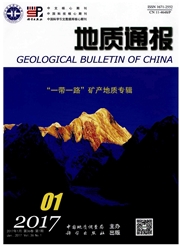

 中文摘要:
中文摘要:
对西秦岭北缘漳县地区上新统韩家沟砾岩的地貌特征、高程分布、沉积特征、构造变形等研究表明:1)该套砾岩分布受西秦岭北缘断层系F2逆冲断层控制,主要由巨砾—中砾砾岩组成,有近源快速磨拉石沉积的特征,代表了上新世以来西秦岭地块沿北缘断层向北逆冲挤出形成的再生前陆磨拉石盆地,指示了西秦岭地块上新世以来的一次强烈的构造隆升。2)这套砾岩出露高程及宏观地貌特征指示了其形成之后又与西秦岭地块一起经历了侵蚀夷平,形成了现今海拔2 600 m 左右统一的夷平面。该夷平面的整体隆升和解体、韩家沟砾岩雅丹地貌形成和发育六级侵蚀阶地或基座阶地的漳河水系形成才真正标志着西秦岭及北缘区域的整体隆升。现今海拔1 800 m 漳河河床与2 600 m 山顶夷平面之间的高差反映了西秦岭及其北缘第四纪以来至少相对隆升了800 m。3)西秦岭北缘漳县韩家沟砾岩下伏的渐新统—中新统红层盆地沉积序列具有伸展断陷盆地充填特征,指示了这个时期西秦岭北缘处于拉张伸展构造状态,也就是说以构造挤压缩短为动力学背景下的青藏高原隆升和构造变形在渐新世—中新世时期尚未扩展至西秦岭北缘区域。尽管该断陷盆地最上部河流相—洪泛相粗碎屑沉积增多和之后地层掀斜及褶皱缩短有可能反映了中新世末或上新世初西秦岭北缘由伸展到挤压的构造转换和构造隆升,但这并不是西秦岭及北缘区域的一次强烈隆升。综上所述,我们认为西秦岭北缘上新统韩家沟砾岩出现标志着西秦岭地块向北强烈逆冲和构造隆升,但西秦岭的这次强烈隆升仅持续到上新统韩家沟砾岩沉积结束,之后西秦岭地块和北部的再生前陆磨拉石盆地一起经历了整体隆升和侵蚀夷平,形成了上新世末或第四纪初的统一夷平面。该山顶夷平面是西秦岭及其?
 英文摘要:
英文摘要:
Based upon the study for the geomorphic characteristics, elevation distribution, sedimentary characteristics and tectonic deformation of Pliocene Hanjigou conglomerates of the northern margin of West Qinling in the Zhangxian area, the following conclusions could be drawn. 1) Pliocene Hanjiagou conglomerate distributed in the north margin of the West Qinling in Zhang County and controlled by south boundary F2 fault, are mainly composed of huge-boulder conglomerates with the near-source and rapid deposition characteristics. It should represent typical regenerated intro-continental foreland molasse basin developed along the northern margin fault, which indicated a strong crustal uplift in the West Qinling massif of the northeast margin of the Qinghai-Tibet Plateau. 2) Although Hanjiagou conglomerate records a rapid rise of the West Qinling massif, this is not the last overall uplift of the northeast margin of the Tibetan Plateau. Its spatial distribution and geomorphic characteristics indicated that after the formation of Hanjiagou conglomerate, it with the western Qinling massif has undergone erosion and razed, finally formed a planation surface which now is about 2 600 m altitude above sea level. The overall uplift and disintegration of this planation surface, development of the Yadang landform of the Hanjiagou conglomerates and Zhanghe River system with six-stage erosion terraces or base terraces documented the whole uplift of the western Qinling and its northern margin. Despite the lack of geological constraints on the pristine elevation of the planation surface, the elevation difference between the 1 800 m present elevation of Zhanghe river and the 2 600 m present elevation of the planation surfaces reflects the West Qinling and its northern margin since the Quaternary at least uplift 800 m. 3) Considering Oligocene-Miocene sedimentary sequences with extension rift basin fillings covered in disconformity by the Hanjiagou conglomerates, which implied that the northern margin of West Qinling was still in ex
 同期刊论文项目
同期刊论文项目
 同项目期刊论文
同项目期刊论文
 期刊信息
期刊信息
